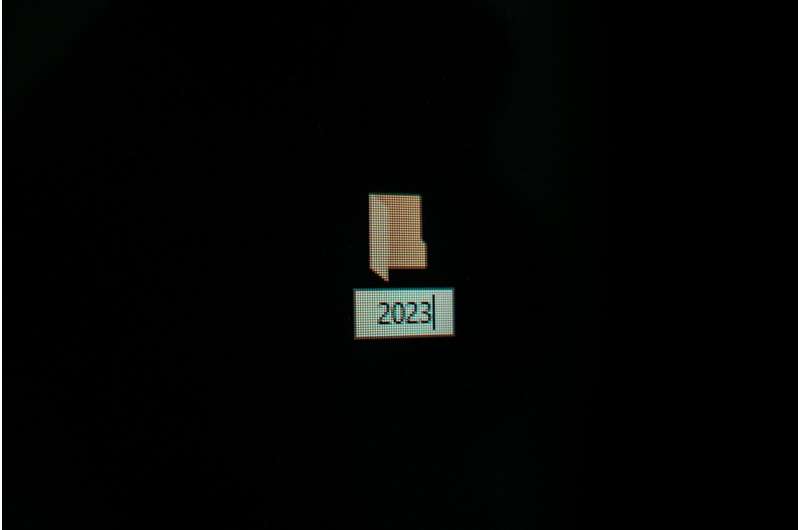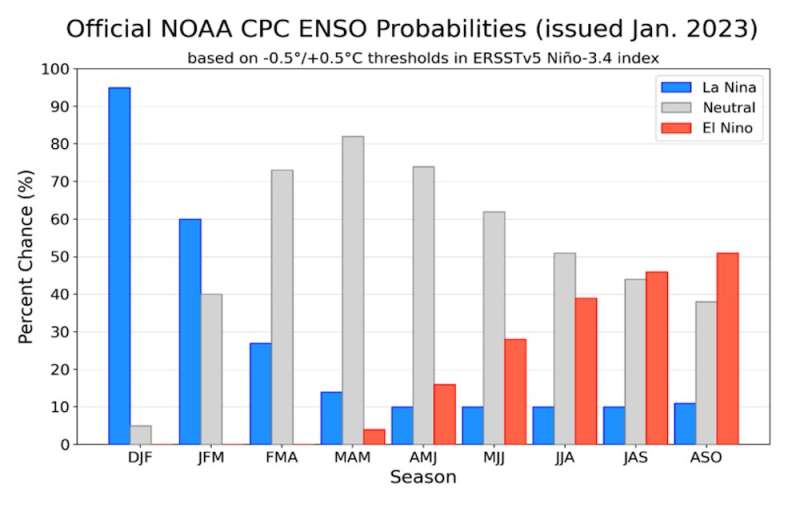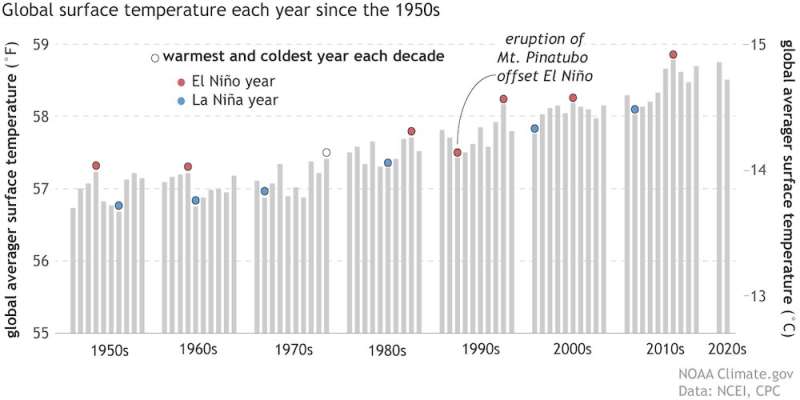This article has been reviewed according to Science X's editorial process and policies. Editors have highlighted the following attributes while ensuring the content's credibility:
fact-checked
trusted source
written by researcher(s)
proofread
Four possible consequences of El Niño returning in 2023

Every two to seven years, the equatorial Pacific Ocean gets up to 3°C warmer (what we know as an El Niño event) or colder (La Niña) than usual, triggering a cascade of effects felt around the world. This cycle is called the El Niño Southern Oscillation (ENSO) because every El Niño is naturally followed by a La Niña and vice versa, with some months of neutral conditions in between events. The change in sea surface temperature associated with ENSO events might seem marginal, but it is more than enough to disrupt weather patterns globally and even the large-scale circulation of air in the polar stratosphere 8km above the Earth.
It is not surprising for La Niña conditions to last two consecutive years, but a three-year La Niña, which the world has had since 2020, is more rare. The US National Oceanic and Atmospheric Administration (NOAA) has reported that the equatorial Pacific Ocean will return to its neutral state between March and May of 2023, and it is likely that El Niño conditions will develop during the northern hemisphere's autumn and winter.
Given the strong influence of ENSO on global patterns of precipitation and temperature, scientists keep a close watch on the status of the tropical Pacific to provide the best possible information. So what can the world expect from the next El Niño event?
1. Likelihood of exceeding 1.5°C
During an El Niño, the ocean transfers some of that excess heat and moisture to the atmosphere, as when you cook pasta and your kitchen gets steamy. On top of the global warming trend, a strong El Niño can add up to 0.2°C to the average temperature of the Earth. The hottest year on record was 2016, during a particularly strong El Niño. A La Niña year can also break heat records, as the warming trend imposed by the increasing accumulation of greenhouse gases in the atmosphere can mask the cooling effect of natural processes.
Since the planet has already warmed by around 1.2°C relative to pre-industrial times and El Niño adds some extra heat to the atmosphere, it's possible that Earth's rising temperature will temporarily exceed the 1.5°C threshold of the Paris agreement some time after the peak of the El Niño in 2024, though it is too early to know how strong this next event will be.

2. More heat, drought and fires in Australia
Australia has had three years of above average rainfall due to prolonged La Niña conditions that brought severe floods, especially in the east. During El Niño, scientists expect the opposite: less rain, higher temperatures and increased fire risk, especially during winter and spring in the southern hemisphere.
As the globe heats up, some regions are warming faster than others. A good example is Australia, which is 1.4°C hotter now than in the early 20th century. Every year, the area of the continent scorched by wildfires increases, fuelled by a dry trend induced by climate change. This occurs despite the anomalous wet years that Australia has experienced during the recent La Niña event. The underlying influence of climate change makes the country extremely vulnerable to the effects of an El Niño.
3. Slower carbon uptake in South America
South America is where the effects of ENSO were first documented by Peruvian fishermen centuries ago. Given the proximity to the equatorial Pacific Ocean, South American weather is significantly disrupted every time an El Niño event occurs, with flooding on the west coasts of Peru and Ecuador and drought in the Amazon and northeast, where the consequences of crop failures can reverberate across the continent.
During El Niño events, the fall in precipitation and rise in temperature in Colombia has been linked to outbreaks of diseases spread by insects, such as malaria and dengue fever. Higher temperatures during El Niño boost the rates at which mosquitoes breed and bite.

Elsewhere during an El Niño, the Amazon rainforest dries and vegetation growth slows so that less CO₂ is absorbed from the atmosphere, a trend repeated in the tropical forests of Africa, India and Australia.
4. Cold winters in northern Europe
The balance between high pressure over the Azores and low pressure over Iceland determines where rain goes in Europe during winter by pushing the jet stream—a band of strong eastward winds that carries rain across the Atlantic—north or south. During El Niño winters, both pressure centers lose strength, and the jet stream brings wetter conditions to southern Europe.
The largest effect is observed in northern Europe, however, where winters become drier and colder. A frosty 2023-24 winter season is likely if El Niño ramps up sufficiently by then. As a result of global warming, scientists expect El Niño's influence over the North Atlantic and northern European winter will strengthen.
Understanding the intricacies of the climate system is similar to trying to assemble a big jigsaw puzzle. The oceans talk to each other, and to the atmosphere, which at the same time feeds back to the ocean. Scientists are still unsure how El Niño will behave in the future, but its effects will probably be amplified by climate change in different regions of the world.
Provided by The Conversation
This article is republished from The Conversation under a Creative Commons license. Read the original article.![]()




















